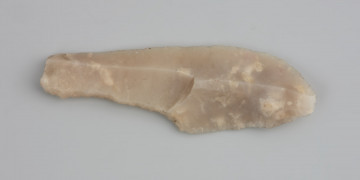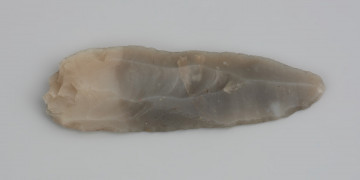
Single-jagged edge
11900 p.n.e. — 11000 p.n.e.
National Museum in Szczecin
Part of the collection: Stone Age
The blade made from the long bone of a deer animal was found by chance during the exploitation of a marl deposit before November 1889 near Gniewino, the Wejherowo district. At that time, a total of four objects were discovered, but two of them were lost. In 1899, they were given to the Szczecin Gesellschaft für Pommersche Geschichte und Altertumskunde by Pastor Trapp of Gniewin. The blade was made from the long bone of an unknown species of animal from the deer family. It is asymmetrical in the cross-section, according to the natural bone curvature. On one side, the apex is neatly sawn and shined, and the so-called impact, i.e., a fracture resulting from an impact on a hard surface, is shown on it. The apex bears marks of several repairs, the last of which was to remove the remains of the impact. These observations suggest that the blade was used for a long time and was originally much more considerable. It appears to be an ad hoc tool made without a specific plan. Bone blades were commonly made by people representing Mesolithic cultures. They were used as arrowheads, javelins, spears and harpoons. Due to climatic conditions, they are well preserved in the peat bogs of northern Europe. Many were accidentally discovered in the 19th century during the industrial exploitation of peat deposits.
Michał Adamczyk
Author / creator
Dimensions
cały obiekt: height: 14 cm, width: 1.3 cm
Object type
perforator
Technique
cutting, smoothing, planing, scraping
Material
deer bone
Origin / acquisition method
acquisition
Creation time / dating
Creation / finding place
Owner
National Museum in Szczecin
Identification number
Location / status

11900 p.n.e. — 11000 p.n.e.
National Museum in Szczecin

11900 p.n.e. — 11000 p.n.e.
National Museum in Szczecin

9600 p.n.e. — 4100 p.n.e.
National Museum in Szczecin
DISCOVER this TOPIC
National Museum in Lublin
DISCOVER this PATH
Educational path